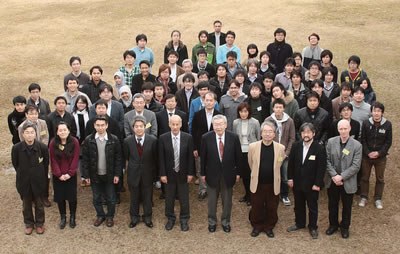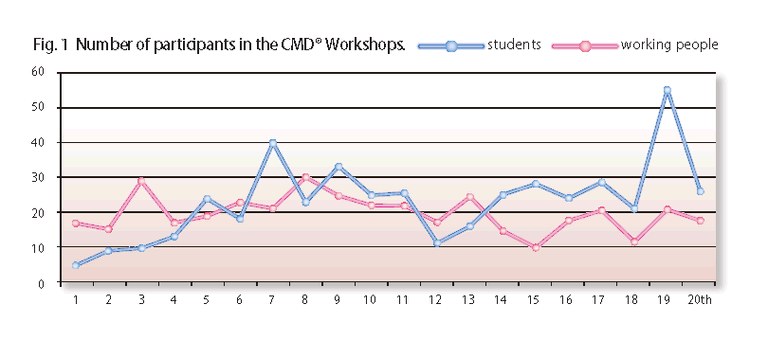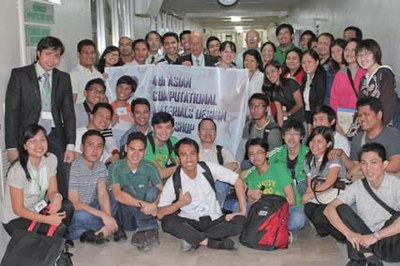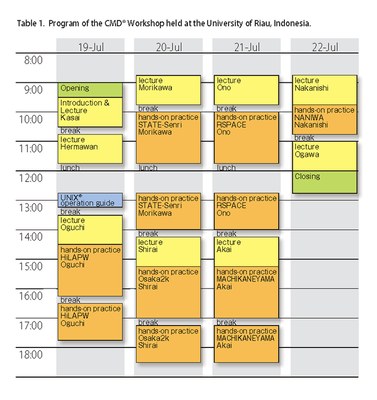10 Years of CMD® Workshops
Tamio Oguchi
Professor
Nanoscience and Nanotechnology Center
Institute of Scientific and
Industrial Research, Osaka University

The 20th Computational Materials Design (CMD®) Workshop was held at the International Institute for Advanced Studies (IIAS) in Kizugawa, Kyoto Prefecture, for five days, from Tuesday, March 6 to Saturday, March 10, 2012. The CMD® Workshops have been held twice a year, and this year marks the 10th anniversary of the establishment of the workshop. In this special report, we introduce the CMD® activities over the past ten years, including the history leading to collaboration with the Computational Materials Science Initiative (CMSI) and survey future prospects.
The Birth of the CMD® Workshop
The entity that became the parent organization for the CMD® Workshops was the specialist training projects at IIAS. In 2001-2002, the first of these projects, “Bio-Informatics,” had been held successfully. The project dealt with new topics of research that could not be covered in the existing graduate schools. Specialists and professors were invited, and seminars and workshops were held for young students using a training camp style. There was an active effort to not merely ensure that the students acquired the target knowledge but rather to create opportunities for bidirectional interchange with the instructors, with the aim of using the synergy to train a group of specialists who would become the future leaders in these areas.
At the time, Osaka University had many researchers specializing in first-principles calculations: Profs. Hisazumi Akai, Hiroshi Yoshida, Hideaki Kasai, Naoshi Suzuki and Kikuo Cho. This background was employed skillfully, resulting in the adoption in 2001 of the “Development of methods for computational nano-materials design” computer-based project of the Japan Science and Technology Corporation (JST) (now the Japan Science and Technology Agency). Through the support from this project, the CMD® Workshop was born in September 2002 as the second IIAS specialist training project.
Computational Materials Design (CMD®) is the theoretical design of new materials and structures in an effort to achieve certain functionalities or properties ̶ in other words, “quantum design.” Specifically, CMD® involves the use of computing power to conduct calculations based on the basic theory of condensed-matter physics. The computer is the basic tool for quantum design. The purpose of the CMD® Workshops is to provide the basic knowledge and techniques needed to enable quantum design.
The lectures in the first CMD® Workshop were held primarily at IIAS, and the handson computer training sessions used the ITBL facility of the Kansai Research Institute of the Japan Atomic Energy Research Institute (JAERI) (now Japan Atomic Energy Agency). Totally 22 participants comprised five graduate students, four university and technical college staffs, 12 private company researchers, and one from a public research organization. For four nights and five days, the lectures continued until around 9 pm every night, with the kind of fulfilling content only possible in a learning camp environment.
Collaboration with CMSI
Subsequently, the CMD® Workshops received support not only from IIAS but also from the New Energy and Industrial Technology Development Organization (NEDO) Materials Nanotechnology Program, the Special Coordination Funds for Promoting Science and Technology, Grant-in-Aid for Scientific Research on Priority Areas, the Program for Training Personnel in Fields to be Promoted and so on, enabling the workshops to be held on an ongoing basis. Figure 1 shows the statistics on the number of students and working people attending the workshops from the first through the 20th workshop. The total number of participants of these 20 workshops came to 858 (461 students and 397 working people).
The large number of participants from private companies was notable from the very beginning, underscoring how few of these types of workshops are held. In October 2004, a Continuing Education Program specially designed for working people was established at Osaka University.
Beginning with the 6th CMD® Workshop, it became mandatory to attend the CMD® Workshop as part of the Continuing Education Program. In addition, credits for this program were accepted as completion of graduate school coursework. Beginning in 2009, these workshops became the Graduatelevel Career-up Programs for Nanoscience and Nanotechnology. Prof. Kasai’s labora-tory was in charge of the secretariat of the workshop from the beginning to this time.
Moreover, since the 18th workshop held inOctober 2011, the CMD® Workshop has alsobeen positioned as one of the activities sponsoredby CMSI. There are several reasons forthis. When the object of quantum design ison a material with unitcell that includesmany atoms or is on a large scale systemsuch as a nanoparticle. large-scale computing is needed, and technology to develop codethat can be executed on such a computer isneeded. CMSI was established in September2010 with the aim of conducting large-scale computing on the K Computer, and so both organizations overlap each other in this context. Their goals also include training people talented for quantum design.
Efforts to accommodate a wide range of participants
The lectures and hands-on training in the first two CMD® Workshops were held in a single class, a system that was equivalent to the content of the subsequent Beginner’s Course. However, the experience and practical skill level of the participants ranged widely, and this created a number of difficulties in the operation of the actual workshop. From the third workshop, a two-course system was introduced, with participants attending courses based on their experience. Several workshops were conducted with the participants attending either the Beginner’s Course or the Advanced Course. Subsequently an Expert Course was also added.
Moreover, to meet the needs of the various participants, a new Supercomputer Course was added beginning with the 17th Workshop (for details, see “CMD®20 Supercomputer Course” on the next page).
In practice, participants come to the CMD® Workshops seeking various things. Beginners first want to experience first-principles calculations, while there are also participants who want to apply. first-principles calculations to specific research topics. These diverse demands requires wide-ranging flexibility.
For example, in most cases, a minimum requirement for conducting first-principles calculations is the ability to enter various commands as instructions on the computer terminal, or to conduct file operations at the UNIX® level. In the beginning, the instructors explained these operations as needed during the lectures. In recent workshops, however, a course on UNIX® has been held on the first day of the Beginner’s Course. Furthermore, in addition to the lectures and hands-on training in the fundamentals of first-principles computing, each workshop features invited lecturers who introduce some case studies of advanced research to show how first-principles computing is applied in the research fields of materials and devices at universities, research laboratories and private companies.
After the end of each CMD® Workshop, an opinion survey is conducted for both participants and lecturers. This is done to know needs with regard to workshop content and system and to point out problems, so these comments can be reflected in future workshop planning and administration.
Expansion to Asian countries
Since around the 10th Workshop, the number of foreigners attending the workshop fromcountries in East Asia has increased. Most ofthese are graduate students studying abroad at Osaka University. There were nine foreignstudents among the participants at the 10th Workshop. Thanks to Prof. Kasai’s effort, by the 19th workshop, this number had grown to 18. On the other hand, this increase in the foreign participants made it difficult to conduct the lectures and hands-on training in Japanese only, and not only the explanatory slides but the oral explanations came to be presented in both Japanese and English. This style of instruction has continued to date, but it has produced problems as well. It often happens that a participants’ question causes the lecturer to engage in animated discussion of a certain subject and the explanation tends to be disproportionately in either Japanese or English, causing frustration with the lecture on the part of the participants.
Although this type of problem sometimes occurs, the acceptance of foreign students has produced major benefits. Interchange with people from the East Asian region through the CMD® Workshop became the inspiration in 2008 for the start of Asian CMD® Workshops in East Asia. In August 2008, the first Asian CMD® Workshop was held at Institute Teknologi Bandung (ITB) in Indonesia.
In September of that same year, an Asian CMD® Workshop was held at De La Salle University in the Philippines. In the following year, 2009, Asian CMD® Workshops were held again in Indonesia and the Philippines and in Vietnam as well. In FY 2010 and FY 2011, the number of countries was expanded to four with the addition of Thailand.
In developing nations in East Asia and other regions, there has always been tremendous interest in and expectations for computational science, and there have been many highly motivated requests to hold CMD® Workshops where young people can be trained using PC-level computing resources.
CMD® Workshop at the University of Riau, Indonesia
The three Asian CMD® Workshops in Indonesia were initially held at ITB, but in July 2011 the workshop was held at the University of Riau as a result of joint sponsorship with the Indonesian Chemical Society (Himpunan Kimia Indonesia / HKI). The workshop was held for four days, from July 19 to July 22. At this point, a brief overview of the workshop will be presented in addition to reports from two of the participants, Irma and Hani, who previously attended Osaka University as part of a Study Abroad program.
The most notable feature of the CMD® Workshop is that it includes not only lectures on the basic theory and detailed techniques of first-principles calculations and their application but also hands-on computer training using first-principles calculation code developed by the instructors. At these Asian CMD® Workshops, through the cooperation of ITB and the University of Riau, a computer server and 50 Linux® terminals were prepared.
Almost all of the 50 participants were people in the field of chemistry from HKI. Many of the participants were using Linux for the first time, and so a large amount of time was devoted to practicing UNIX® operations. The program for the CMD® Workshop is shown in Table 1. The hands-on computer training was conducted using six types of firstprinciples calculation code: HiLAPW, STATE-Senri, Osaka2k, RSPACE, MACHIKANEYAMA and NANIWA. Each lecture lasted approximately one hour, with approximately three hours allocated for practical training. Rather than theory, the emphasis was placed on actually experiencing various kinds of calculations.
From the host side, Prof. Hermawan of ITB provided an introductory lecture on firstprinciples calculation. There were many opportunities for interchange between participants and instructors, both during the lecture and during the lunch period and the fellowship gathering, so the positive aspects of the CMD® Workshops could be observed in the Asian CMD® Workshops as well. In particular, it is to be hoped that the fact that participants and instructors with such different cultural backgrounds were able to share the experience of the workshop over a four-day period will prove valuable in future mutual understanding and research interchange between Japan and Indonesia.



